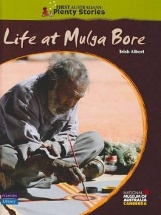First Australians: Plenty Stories (series) by Trish Albert

National Museum of Australia, 2009.
Life at Mulga Bore.
Indigenous sporting heroes.
24/32pp, col ill.
First Australians: Plenty stories is a series of books showing what
it means to be an Aboriginal or Toorres Strait Island person in
Australia today. Through different modes of storytelling, we are
given some of their history and culture through stories, snapshots
of people, photographs and a fact file. Each book is colourful, easy
to read with large print and wide margins, with a brief but useful
index, contents page and glossary. For classes looking for two most
accessible books to give their students when researching Aboriginal
life today, then these would be most useful.
I was only sent these two, but looking at the National Museum of
Australia website, you can see that there are many more. 2 packs are
made for primary students with 9 books and teacher notes in each. A
teacher resource book and a poster pack can be bought as well. All
can be ordered online from the National Museum of Australia.
The first, Indigenous sporting greats, has Nicky Winmar on the cover
in what is now a famous photo of him showing his skin to people who
were racially abusing him. Inside the book are outlines of a range
of Aboriginal and Torres Strait Island sports people, Jerry Jerome,
Eddie Gilbert, Sir Doug Nicholls, Evonne Cawley, Cathy Freeman,
Michael Long, as well as the front cover person, Nicky Winmar. Each
double page gives a potted history of that person, with a small fact
file and several photos. Each is informative and tells of the
struggles that person had to achieve what they did.The introduction,
Against the odds, frames the stories, showing that these people did
in fact achieve against the odds, and the final section poses the
question about sport being a place where all players can respect one
another.
Life at Mulga Bore is part of the upper primary set group of books
and has 32 pages, with many more illustrations and information.
Mulga Bore is a small community north of Alice Springs, and is home
to seven related families of the Anmatyerr group of people. One of
their number, Lindsay Bird Mpetyane is a painter, and through the
book, we are shown him painting Bush Plum Dreaming. Through this
painting we see and hear about his lifestyle, his painting methods,
his background and how the community survives. It is a bird's eye
view of the strength of a small community and its central figures,
and will enrich primary students' understanding of the lives of some
Aboriginal people today.
Fran Knight